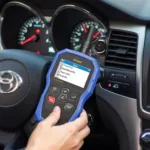The dreaded P0134 OBD2 code is a common issue for Volkswagen (VW) owners. This code signifies a problem with the oxygen sensor (O2 sensor), specifically the heated oxygen sensor (HO2S) Bank 1 Sensor 1, located before the catalytic converter. Understanding this code, its causes, and solutions can save you time and money.
Decoding the OBD2 Code P0134 in Your VW
The P0134 code specifically indicates a lack of activity from the HO2S Bank 1 Sensor 1. This sensor plays a critical role in monitoring the exhaust gases and adjusting the air/fuel mixture for optimal engine performance and emissions control. When the sensor fails to send a signal, your VW’s engine control unit (ECU) can’t accurately regulate the fuel mixture, leading to various issues.
What Causes OBD2 Code P0134 in VWs?
Several factors can trigger the P0134 code in your Volkswagen. These include:
- Faulty Oxygen Sensor: The most common culprit is a failing oxygen sensor itself. Over time, these sensors degrade due to exposure to high temperatures and exhaust gases.
- Wiring Issues: Damaged or corroded wiring and connectors in the sensor circuit can disrupt the signal transmission.
- Exhaust Leaks: Leaks in the exhaust system upstream of the sensor can introduce fresh air, affecting the sensor readings.
- Vacuum Leaks: Unmetered air entering the engine through vacuum leaks can also disrupt the air/fuel mixture and trigger the code.
- Fuel Pressure Issues: Incorrect fuel pressure can cause a rich or lean fuel mixture, leading to inaccurate sensor readings.
- Faulty ECU: While less common, a malfunctioning ECU can sometimes misinterpret sensor data and trigger the P0134 code.
 OBD2 Code P0134 VW Oxygen Sensor Location
OBD2 Code P0134 VW Oxygen Sensor Location
Recognizing the Symptoms of P0134
While the check engine light is the most obvious sign, other symptoms can accompany the P0134 code:
- Decreased Fuel Economy: A malfunctioning oxygen sensor can lead to a richer fuel mixture, resulting in lower fuel mileage.
- Rough Idle: The engine may idle rough or unevenly due to the incorrect air/fuel ratio.
- Hesitation or Stalling: You might experience hesitation or stalling during acceleration or at idle.
- Failed Emissions Test: The P0134 code often results in a failed emissions test.
How to Fix OBD2 Code P0134 in Your VW
Diagnosing and fixing the P0134 code requires a systematic approach:
- Scan for Codes: Use an OBD2 scanner to confirm the P0134 code and check for any other related codes.
- Inspect Wiring and Connectors: Carefully examine the wiring and connectors for damage, corrosion, or loose connections. Repair or replace any faulty components.
- Check for Exhaust Leaks: Inspect the exhaust system for leaks, particularly upstream of the oxygen sensor. Repair any leaks found.
- Test the Oxygen Sensor: Use a multimeter to test the oxygen sensor’s voltage output. A failing sensor will typically have a low or erratic voltage reading.
- Replace the Oxygen Sensor: If the sensor is faulty, replace it with a high-quality OEM or equivalent part.
- Check Fuel Pressure: Test the fuel pressure to ensure it’s within the manufacturer’s specifications. Address any fuel pressure issues.
- Inspect the ECU: If all other components check out, a faulty ECU might be the cause. Consult a qualified mechanic for ECU diagnosis and repair.
“Regularly checking and maintaining your vehicle’s oxygen sensors can prevent costly repairs down the line,” advises John Miller, ASE Certified Master Technician. “Early diagnosis and repair can significantly extend the life of your catalytic converter.”
Conclusion: Addressing OBD2 Code P0134 in Your VW
The OBD2 code P0134 in your VW indicates a problem with the oxygen sensor and requires prompt attention. By understanding its causes, symptoms, and fixes, you can effectively address the issue and keep your VW running smoothly. Ignoring this code can lead to further damage and increased repair costs, so don’t delay in getting it diagnosed and fixed.
FAQs about OBD2 Code P0134 VW
- Can I drive my VW with a P0134 code? While you can drive short distances, prolonged driving with this code can damage your catalytic converter and decrease fuel efficiency.
- How much does it cost to fix a P0134 code? The cost varies depending on the cause and the repair required, but it typically ranges from $100 to $300.
- How often should I replace my oxygen sensors? Most manufacturers recommend replacing oxygen sensors every 60,000 to 90,000 miles.
- Can a bad catalytic converter cause a P0134 code? While less common, a failing catalytic converter can sometimes affect oxygen sensor readings and trigger the code.
- Where is the Bank 1 Sensor 1 oxygen sensor located? It’s typically located in the exhaust manifold, before the catalytic converter.
- What other codes are related to the P0134 code? Related codes might include P0130, P0131, P0132, P0133, and P0135, which indicate other issues with the same oxygen sensor circuit.
- Can I replace the oxygen sensor myself? Replacing an oxygen sensor is a relatively straightforward DIY task for those with basic mechanical skills.
“Investing in a quality OBD2 scanner allows you to monitor your car’s health and catch potential issues early,” adds Sarah Johnson, Automotive Engineer. “This proactive approach can save you money and headaches in the long run.”
Need assistance? Contact us via WhatsApp: +1(641)206-8880, Email: [email protected]. We have a 24/7 customer support team.
